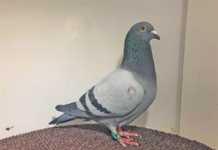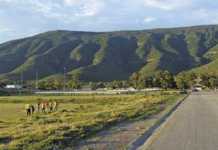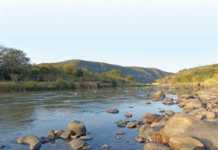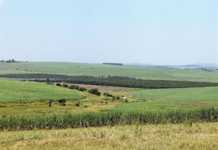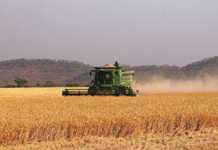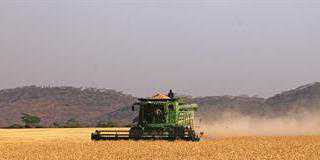The caves. The farm name is apt. For just over 120 years the central cave on this Barkly East farm has been the epicentre of the Steyn family’s farming operations. “We’ve always done everything in here,” says current owner Piet Steyn, who farms with livestock and tulips and is also the principal of a local school.
“I was born here and grew up here. We used to milk 25 cows every morning and evening in the cave. I still milk cows here and also shear sheep, and store bales, equipment, wood and my tulip bulbs.” After Piet’s great grandfather Nicholas Johannes Steyn blew up the rock obstructing the entrance with homemade dynamite, the cave was divided in two, one side used as a kraal and storage area and one for shearing sheep. “A walnut tree planted near the cave gives off a natural gas that keeps the flies away,” says Piet.
On Vredehoek farm in the Langkloof Valley, a cave protects livestock during the region’s vicious winters. ”When it snowed, the lambs and ewes would be brought into the cave,” recalls 80-year-old Jossie Fouche. “Water dripped out of the sandstone and was captured for drinking, and the sheep were fed lucerne. They’d be dry and happy.”
The San and the settlers
The first to use the caves were the San. They would follow the eland into the region during the summer, explains farmer and aeronautical engineer, Erasmus “Rassie” Smith, whose great grandfather settled on the farm Maartinsdell near the town of Rhodes in the mid-1880s. But by 1908, when the last eland was shot in the area, the San had also disappeared. In fact, from the moment settler wagons started creaking into the district, competition for resources between the San and settlers began – and among these resources were the shelter and protection of the caves.
The clash of cultures can be clearly seen in the cave on Burley farm, which is in the hands of another pioneer family, the Brummers. Tucked away in a valley of sheer sandstone cliffs near the Kraai River, the cave is filled with paintings of eland, but around its entrance, the stone wall built by pastoralist settlers is still visible. “Everywhere you see ruins of stone kraals, where people were looking after stock. There were no fences in that time, and predators must have been a major problem. There were leopards, and lions would have come up after the eland,” says Rassie.
In fact, many settlers new to the region not only kraaled their stock in former San caves, they also lived in them. There’s the well-constructed cottage built in a cave on Glengyle farm by the Sephtons in the late 1860s. They stayed there while their sandstone home was being built nearby. Both buildings stand today on land that still belongs to the family. “It’s not very smart to build a home in a south-facing cave,” chuckles Ross Sephton. “Can you imagine how cold it got here?”
Fuel was a problem, he adds, as there were few trees, only shrubs like ou-hout. Livestock dung was therefore a valuable commodity. It was collected from the kraal and splattered against the cave wall to dry – often over San paintings. “Those are marks made by cow patties,” says Ross, pointing to the faded circular blotches that mar numerous paintings.
If the San suffered with the coming of the settlers – and the other “tribes” who hunted them down – they offered stiff resistance before being completely wiped out. They stole and killed the domesticated stock kraaled in the very caves they used to frequent – and woe betide anyone who got in their way, like the unfortunate Mrs Henning, who was bludgeoned to death in a Barkly East cave while checking on the family’s ewes and lambs.
Such incidents triggered retaliation by settlers, who pursued and killed San on horseback. Informal soldiers in an informal war, they’d never leave home without a supply of pumpkin pips that would be split open and applied to arrow wounds to extract as much poison as possible.
Basotho raiders
However, it was raids by the Basotho from beyond the Witteberge in the 1880s that had many settlers jittery about their future. The instability brought about by the raids is still remembered in local place names, such as Wartrail and Mosheshesford. During the raids, settlers would retreat to farms such as Maartinsdell. Women and children took shelter in the farm’s huge cave, where they were guarded by a few armed men, while the rest faced the bandits.
The Basotho raiders’ main prize was horses, and one of their leaders was Morosi, who ruled from the modern-day Lesotho town of Quithing. “The people used to call him Mooi Roos,” says Rassie. After fending off the raiders, the farmers would go after them to retrieve the stolen stock. And now it was the Basotho who would hide in caves, particularly in the rugged Joggem River Valley.
The caves today
Today, the region’s caves are still used. “The huge cave on Maartinsdell still acts as the main shed on the farm,” says Rassie. “In a way it’s actually a disadvantage to the farm – the people never built a shed because of this huge holkrans.” After almost 130 years, the farm’s household water is still sourced from a spring in the depths of the cave, behind the tractors, implements, vehicles and pens where Rassie recently reared ostriches.
He recalls how impressed he was as a teenager in the 1960s to see a Diamond T truck from the South African railways turn in the cave after collecting wool from the farm. The stable in the cave accommodated his grandfather’s first automobile in 1918. Rassie dreams of celebrating the cave’s contributions to the family by bringing music to it. “I’d love to have a string quartet perform in here,” he says. “The acoustics would be perfect.”

